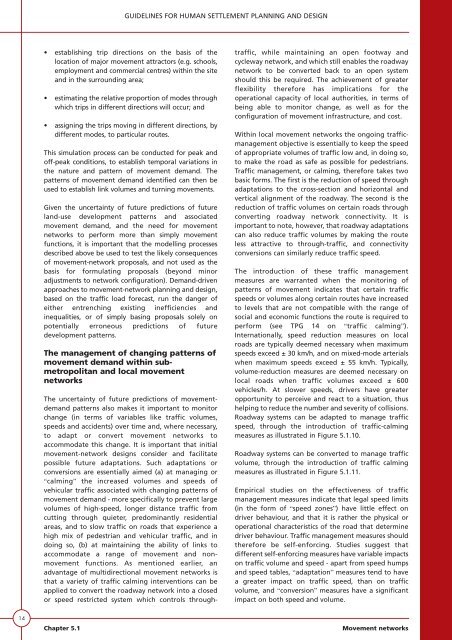VOLUME 1 HUMAN SETTLEMENT PLANNING AND ... - CSIR
VOLUME 1 HUMAN SETTLEMENT PLANNING AND ... - CSIR
VOLUME 1 HUMAN SETTLEMENT PLANNING AND ... - CSIR
- No tags were found...
Create successful ePaper yourself
Turn your PDF publications into a flip-book with our unique Google optimized e-Paper software.
GUIDELINES FOR <strong>HUMAN</strong> <strong>SETTLEMENT</strong> <strong>PLANNING</strong> <strong>AND</strong> DESIGN• establishing trip directions on the basis of thelocation of major movement attractors (e.g. schools,employment and commercial centres) within the siteand in the surrounding area;• estimating the relative proportion of modes throughwhich trips in different directions will occur; and• assigning the trips moving in different directions, bydifferent modes, to particular routes.This simulation process can be conducted for peak andoff-peak conditions, to establish temporal variations inthe nature and pattern of movement demand. Thepatterns of movement demand identified can then beused to establish link volumes and turning movements.Given the uncertainty of future predictions of futureland-use development patterns and associatedmovement demand, and the need for movementnetworks to perform more than simply movementfunctions, it is important that the modelling processesdescribed above be used to test the likely consequencesof movement-network proposals, and not used as thebasis for formulating proposals (beyond minoradjustments to network configuration). Demand-drivenapproaches to movement-network planning and design,based on the traffic load forecast, run the danger ofeither entrenching existing inefficiencies andinequalities, or of simply basing proposals solely onpotentially erroneous predictions of futuredevelopment patterns.The management of changing patterns ofmovement demand within submetropolitanand local movementnetworksThe uncertainty of future predictions of movementdemandpatterns also makes it important to monitorchange (in terms of variables like traffic volumes,speeds and accidents) over time and, where necessary,to adapt or convert movement networks toaccommodate this change. It is important that initialmovement-network designs consider and facilitatepossible future adaptations. Such adaptations orconversions are essentially aimed (a) at managing or“calming” the increased volumes and speeds ofvehicular traffic associated with changing patterns ofmovement demand - more specifically to prevent largevolumes of high-speed, longer distance traffic fromcutting through quieter, predominantly residentialareas, and to slow traffic on roads that experience ahigh mix of pedestrian and vehicular traffic, and indoing so, (b) at maintaining the ability of links toaccommodate a range of movement and nonmovementfunctions. As mentioned earlier, anadvantage of multidirectional movement networks isthat a variety of traffic calming interventions can beapplied to convert the roadway network into a closedor speed restricted system which controls throughtraffic,while maintaining an open footway andcycleway network, and which still enables the roadwaynetwork to be converted back to an open systemshould this be required. The achievement of greaterflexibility therefore has implications for theoperational capacity of local authorities, in terms ofbeing able to monitor change, as well as for theconfiguration of movement infrastructure, and cost.Within local movement networks the ongoing trafficmanagementobjective is essentially to keep the speedof appropriate volumes of traffic low and, in doing so,to make the road as safe as possible for pedestrians.Traffic management, or calming, therefore takes twobasic forms. The first is the reduction of speed throughadaptations to the cross-section and horizontal andvertical alignment of the roadway. The second is thereduction of traffic volumes on certain roads throughconverting roadway network connectivity. It isimportant to note, however, that roadway adaptationscan also reduce traffic volumes by making the routeless attractive to through-traffic, and connectivityconversions can similarly reduce traffic speed.The introduction of these traffic managementmeasures are warranted when the monitoring ofpatterns of movement indicates that certain trafficspeeds or volumes along certain routes have increasedto levels that are not compatible with the range ofsocial and economic functions the route is required toperform (see TPG 14 on “traffic calming”).Internationally, speed reduction measures on localroads are typically deemed necessary when maximumspeeds exceed ± 30 km/h, and on mixed-mode arterialswhen maximum speeds exceed ± 55 km/h. Typically,volume-reduction measures are deemed necessary onlocal roads when traffic volumes exceed ± 600vehicles/h. At slower speeds, drivers have greateropportunity to perceive and react to a situation, thushelping to reduce the number and severity of collisions.Roadway systems can be adapted to manage trafficspeed, through the introduction of traffic-calmingmeasures as illustrated in Figure 5.1.10.Roadway systems can be converted to manage trafficvolume, through the introduction of traffic calmingmeasures as illustrated in Figure 5.1.11.Empirical studies on the effectiveness of trafficmanagement measures indicate that legal speed limits(in the form of “speed zones”) have little effect ondriver behaviour, and that it is rather the physical oroperational characteristics of the road that determinedriver behaviour. Traffic management measures shouldtherefore be self-enforcing. Studies suggest thatdifferent self-enforcing measures have variable impactson traffic volume and speed - apart from speed humpsand speed tables, “adaptation” measures tend to havea greater impact on traffic speed, than on trafficvolume, and “conversion” measures have a significantimpact on both speed and volume.14Chapter 5.1Movement networks
















